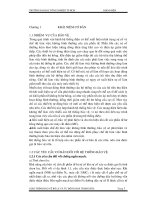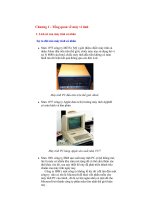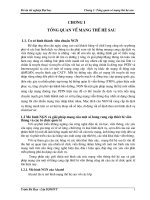1 GDP
Bạn đang xem bản rút gọn của tài liệu. Xem và tải ngay bản đầy đủ của tài liệu tại đây (864.49 KB, 47 trang )
Measuring a Nation’s
Income
Copyright © 2004 South-Western
1
Measuring a Nation’s Income
• Microeconomics
• Microeconomics is the study of how individual
households and firms make decisions and how they
interact with one another in markets.
• Macroeconomics
• Macroeconomics is the study of the economy as a
whole.
• Its goal is to explain the economic changes that
affect many households, firms, and markets at once.
Copyright © 2004 South-Western
Measuring a Nation’s Income
• Macroeconomics answers questions like the
following:
• Why is average income high in some countries and
low in others?
• Why do prices rise rapidly in some time periods
while they are more stable in others?
• Why do production and employment expand in
some years and contract in others?
Copyright © 2004 South-Western
THE ECONOMY’S INCOME AND
EXPENDITURE
• When judging whether the economy is doing
well or poorly, it is natural to look at the total
income that everyone in the economy is
earning.
Copyright © 2004 South-Western
THE ECONOMY’S INCOME AND
EXPENDITURE
• For an economy as a whole, income must equal
expenditure because:
• Every transaction has a buyer and a seller.
• Every dollar of spending by some buyer is a dollar
of income for some seller.
Copyright © 2004 South-Western
THE MEASUREMENT OF GROSS
DOMESTIC PRODUCT
• Gross domestic product (GDP) is a measure of
the income and expenditures of an economy.
• It is the total market value of all final goods and
services produced within a country in a given
period of time.
Copyright © 2004 South-Western
THE MEASUREMENT OF GROSS
DOMESTIC PRODUCT
• The equality of income and expenditure can be
illustrated with the circular-flow diagram.
Copyright © 2004 South-Western
Figure 1 The Circular-Flow Diagram
MARKETS
FOR
GOODS AND SERVICES
•Firms sell
Goods
•Households buy
and services
sold
Revenue
Wages, rent,
and profit
Goods and
services
bought
HOUSEHOLDS
•Buy and consume
goods and services
•Own and sell factors
of production
FIRMS
•Produce and sell
goods and services
•Hire and use factors
of production
Factors of
production
Spending
MARKETS
FOR
FACTORS OF PRODUCTION
•Households sell
•Firms buy
Labor, land,
and capital
Income
= Flow of inputs
and outputs
= Flow of dollars
Copyright © 2004 South-Western
THE MEASUREMENT OF GROSS
DOMESTIC PRODUCT
• GDP is the market value of all final goods and
services produced within a country in a given
period of time.
Copyright © 2004 South-Western
THE MEASUREMENT OF GROSS
DOMESTIC PRODUCT
• “GDP is the Market Value . . .”
• Output is valued at market prices.
• “. . . Of All Final . . .”
• It records only the value of final goods, not
intermediate goods (the value is counted only once).
• “. . . Goods and Services . . . “
• It includes both tangible goods (food, clothing, cars)
and intangible services (haircuts, housecleaning,
doctor visits).
Copyright © 2004 South-Western
THE MEASUREMENT OF GROSS
DOMESTIC PRODUCT
• “. . . Produced . . .”
• It includes goods and services currently produced,
not transactions involving goods produced in the
past.
• “ . . . Within a Country . . .”
• It measures the value of production within the
geographic confines of a country.
Copyright © 2004 South-Western
THE MEASUREMENT OF GROSS
DOMESTIC PRODUCT
• “. . . In a Given Period of Time.”
• It measures the value of production that takes place
within a specific interval of time, usually a year or a
quarter (three months).
Copyright © 2004 South-Western
THE COMPONENTS OF GDP
• GDP includes all items produced in the
economy and sold legally in markets.
Copyright © 2004 South-Western
THE COMPONENTS OF GDP
What Is Not Counted in GDP?
• GDP excludes most items that are produced and
consumed at home and that never enter the
marketplace.
• It excludes items produced and sold illicitly, such as
illegal drugs.
• It excludes intermediate goods
• It excludes welfare payments or Social Security
payments to households. These are transfer
payments, which are not part of the government
purchases component of GDP.
Copyright © 2004 South-Western
THE COMPONENTS OF GDP
Good
Logs
Produced by Purchased by
Logger
Sawmill
Lumber
Sawmill
Construction firm $25,000 $13,000
Construction
Household
$125,000 $100,000
firm
Final Value
$125,000
House
Sum of Values
Added
Price
$12,000
Value
Added
$12,000
$125,000
Copyright © 2004 South-Western
THE COMPONENTS OF GDP
• GDP (Y) is the sum of the following:
•
•
•
•
Consumption (C)
Investment (I)
Government Purchases (G)
Net Exports (NX)
Y = C + I + G + NX
Copyright © 2004 South-Western
THE COMPONENTS OF GDP
• Consumption (C):
• The spending by households on goods and services,
with the exception of purchases of new housing.
• Investment (I):
• The spending on capital equipment, inventories, and
structures, including new housing.
Copyright © 2004 South-Western
Heads Up!
The term “investment” can generate confusion. In
everyday conversation, we use the term “investment” to
refer to uses of money to earn income - we have invested
in a stock or invested in a bond. Economists, however,
restrict “investment” to activities that increase the
economy’s stock of capital. The purchase of a share of
stock does not add to the capital stock; it is not
investment in the economic meaning of the word. We
refer to the exchange of financial assets, such as stocks or
bonds, as financial investment to distinguish it from the
creation of capital that occurs as the result of investment.
Only when new capital is produced does investment
occur.
Copyright © 2004 South-Western
THE COMPONENTS OF GDP
• Government Purchases (G):
• The spending on goods and services by local, state,
and federal governments.
• Does not include transfer payments because they
are not made in exchange for currently produced
goods or services.
• Net Exports (NX):
• Exports minus imports.
Copyright © 2004 South-Western
Table 1 GDP and Its Components
Copyright©2004 South-Western
Components of GDP at current
market prices, EU-28, 2016
Copyright © 2004 South-Western
REAL VERSUS NOMINAL GDP
• Nominal GDP values the production of goods
and services at current prices.
• Real GDP values the production of goods and
services at constant prices.
Copyright © 2004 South-Western
REAL VERSUS NOMINAL GDP
• An accurate view of the economy requires
adjusting nominal to real GDP by using the
GDP deflator.
Copyright © 2004 South-Western
Table 2 Real and Nominal GDP
Copyright©2004 South-Western
Table 2 Real and Nominal GDP
Copyright©2004 South-Western









